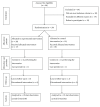Does motor training of the nonparetic side influences balance and function in chronic stroke? A pilot RCT
- PMID: 25506618
- PMCID: PMC4251094
- DOI: 10.1155/2014/769726
Does motor training of the nonparetic side influences balance and function in chronic stroke? A pilot RCT
Abstract
Background: Balance and functional abilities are controlled by both sides of the body. The role of nonparetic side has never been explored for such skills.
Objective: The objective of the present study was to examine the effect of a motor therapy program primarily involving the nonparetic side on balance and function in chronic stroke.
Method: A randomized controlled, double blinded trial was conducted on 39 poststroke hemiparetic subjects (21, men; mean age, 42 years; mean poststroke duration, 13 months). They were randomly divided into the experimental group (n = 20) and control group (n = 19). The participants received either motor therapy focusing on the nonparetic side along with the conventional program or conventional program alone for 8 weeks (3 session/week, 60 minutes each). The balance ability was assessed using Berg Balance Scale (BBS) and Functional Reach Test (FRT) while the functional performance was measured by Barthel Index (BI).
Result: After intervention, the experimental group exhibited significant (P < 0.05) change on BBS (5.65 versus 2.52) and BI (12.75 versus 2.16) scores in comparison to the control group.
Conclusion: The motor therapy program incorporating the nonparetic side along with the affected side was found to be effective in enhancing balance and function in stroke.
Figures


References
-
- Nichols D. S. Balance retraining after stroke using force platform biofeedback. Physical Therapy. 1997;77(5):553–558. - PubMed
Publication types
MeSH terms
LinkOut - more resources
Full Text Sources
Other Literature Sources
Medical

